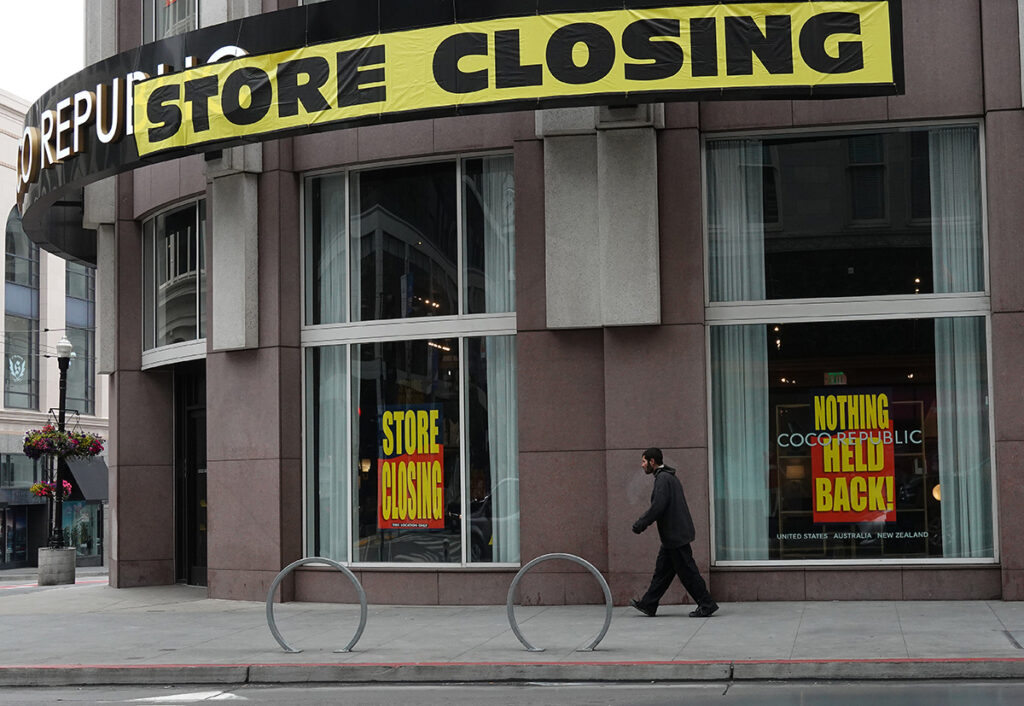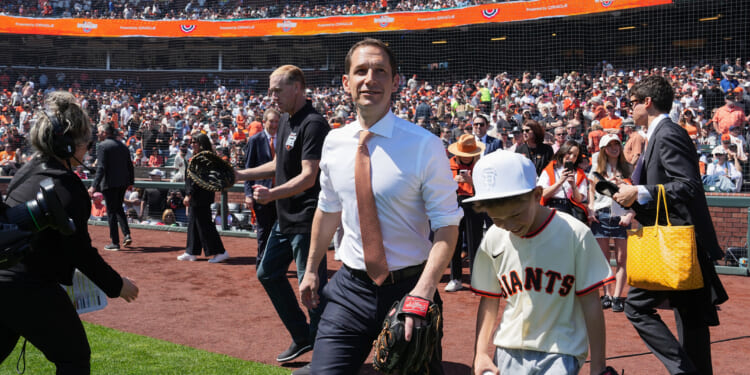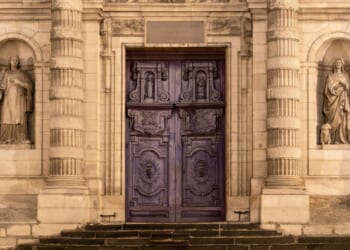The first direct action taken by an operative of the San Francisco 10X Project was the installation of an unauthorized tree swing on a grassy knoll in Bernal Heights. Mechanically, the operation was simple: scale the towering cypress, loop thick rope through one of the low-hanging branches, and tie up a plank. The wrinkle was the park ranger. He showed up halfway through, chastised the operative for creating a safety hazard, and took the swing down.
A day later, the swing reappeared—this time affixed with adhesive-secured bolts and chains rated for 600 pounds and engraved with the phrase “You can just do things (at your own risk).” After a week, the Parks Department dismantled it. Sixteen hours later, it was up again.
Finally, a reason to check your email.
Sign up for our free newsletter today.
The skirmish, which began in February, continued unacknowledged (except in Bernal Heights and on niche corners of X) until May, when the San Francisco Standard profiled the “Swing Man,” as he asked to be called, and his “guerrilla effort” to keep the contraption up. By this point, the swing had developed a cult following among locals. Each time the Parks Department took it down, the Swing Man put it back up in less than a day. “I will keep doing this until the sun swallows the Earth,” he told the reporter.
Taken on its own, the swing was an inspiring, if minor, act of rebellion against the joyless administrative state. It laid bare the priorities of a department that will chop down a rope swing with obsessive zeal but allow people to smoke meth around children’s playgrounds, provided they appear sufficiently disheveled. In a final irony, it turned out that earlier versions of the Parks Department logo itself had featured a girl on a tree swing—an image that its spokesperson insisted was “meant to capture a feeling”—in this case, of play and joy—“not serve as a how-to for DIY park equipment.”
The swing was no isolated act. It was the first in a series of proofs of concept executed by the SF 10X Project. Founded in autumn 2024 by Wolf Tivy—creator and former editor-in-chief of Palladium, a political philosophy magazine—10X’s mission is, as the name implies, making San Francisco ten times better. It is organized around the realization of five theses: 1) San Francisco should have more housing and transportation; 2) a child should be able to walk barefoot on any city street; 3) government should be “lean, meritocratic, and magnificent”; 4) local schools should attract, not repel, families; and 5) San Francisco should lead an American industrial renaissance.
Though advanced in bracing language, these are not novel ideas. Many have circulated for years in reform-minded circles. What is novel, at least in San Francisco’s current political context, is the 10X bias for direct action. Since the project’s creation, 10X members have commissioned and unveiled a marble bust of the late programmer and hacktivist Aaron Swartz; organized weekly trash pickups around the Mission District; reassembled the swing within hours of its destruction; and hosted a civics hackathon that drew hundreds of participants. Ultimately, what sets 10X apart is its combination of radical idealism with real-world activity. In this, it rejects both the online commentariat’s costless critique and the city political class’s compromise-addicted approach to governance. In that refusal lies an ethic of civic renewal—the kind that San Francisco will need if it is to emerge from its years of dysfunction.
A full accounting of the policy failures, cultural hysteria, and wanton greed that made San Francisco the poster child of American urban disarray in the early 2020s would run to several hundred pages. But it’s worth recalling the broad contours and some standout excesses, if only to underscore just how bad things became.
The immediate precipitant of San Francisco’s crisis was the Covid-19 pandemic. As school and work shifted online in mid-2020, a larger proportion of the city’s residents left than in any other major metropolitan area in the country. Remote work and cratering tourism meant less demand for office space and retail stores, fewer riders on public transit, and less foot traffic downtown. Office vacancy rates reached unprecedented levels and have continued to climb, to today’s almost 35 percent vacancy rate. Unemployment shot up from 2.5 percent to over 14 percent, and visitor spending declined by more than 70 percent. Crime and public degeneracy flourished. Burglary, car theft, and assaults all increased, and the count of “tent-like structures” on city streets hit record highs.
The main driver of this downswing—a global pandemic combated with a policy of enforced social withdrawal—was beyond the purview of local politicians. But that didn’t stop many from ensuring that the decline was as protracted and publicly damaging as possible. Of primary concern in those early days was the well-being of the local unsheltered homeless population. Until then, the city had generally allowed this largely drug-addicted and mentally ill group to live and die in squalor on the streets, provided that they chose these deaths of their own free will. But once the homeless were identified as potential vectors for spreading Covid, officials moved quickly to contain them.
Their first attempt was the “safe sleeping village,” a government-run homeless encampment set up in front of City Hall with neatly drawn, evenly spaced, white chalk rectangles marking socially distanced lots for each tent. City employees delivered food and water to the tents several times daily and eventually even opened a dedicated drug consumption site (known euphemistically as a “linkage center”) to cater to residents’ needs. Though the village housed only about 160 people at its peak, the aerial shot of tents set against the vacant center of government became one of the iconic images of pandemic-era San Francisco.
The village was soon followed by “Shelter-in-Place Hotels,” an initiative that invested about $385 million in state and local funds to lease hundreds of hotel rooms for the homeless. The effort was, on balance, an unmitigated failure. Drug dealers swarmed the hotel lobbies, dozens of people overdosed and died in their rooms, and several hotel owners later sued the city for damages caused by unstable tenants, ultimately winning over $44 million in collective settlements.
And then, of course, there were the schools. Before its most radical members got recalled in a special election, the city’s school board voted to keep the schools closed for over a year—longer than almost any other major school district in the country—while debating whether to destroy a mural of George Washington and rename dozens of schools in an effort to combat white supremacy. It also voted to replace merit-based admissions at Lowell, the city’s most prestigious public high school, with a lottery system. After old tweets resurfaced in which then–board vice president Allison Collins called Asians “house n——,” the board briefly turned its attention inward and voted to strip her of her title. A week later, Collins responded by suing the school district—then facing a budget deficit over $100 million—for $87 million in damages, though the suit was ultimately tossed.
When moral panic gripped the nation after the death in police custody of George Floyd in Minneapolis, San Francisco officials responded by diverting hundreds of millions of dollars from the police department and the general fund into a grant program charged with the expansive mandate of “ensuring black joy.” The program has since been scaled back after it emerged that its director, now under criminal investigation, steered tens of millions of dollars in grant money to her boyfriend’s nonprofit and wrote off lavish vacations on Martha’s Vineyard. In parallel, the city created a reparations committee whose first report—which received unanimous support at an initial hearing of the Board of Supervisors—recommended paying all eligible black people in San Francisco $5 million and supplementing their household income to match the area median income for at least the next 250 years. As it turned out, the enthusiastic support was little more than Kabuki theater; the reparations proposal was shelved and never spoken of again, once the posture of contrived self-flagellation from which it emerged fell out of favor.
Amid all this chaos, one of the most destabilizing and consequential elements was the presence of Chesa Boudin, the Hugo Chávez acolyte and Weather Underground scion, who, as district attorney starting in January 2020, pursued a policy of radical decarceration. In his first address as DA, Boudin urged his fellow San Franciscans to join him in “rejecting the notion that to be free, we must cage others.” Under Boudin, drug-dealing convictions nearly vanished, diversions for retail theft skyrocketed, and overall prosecutions fell by more than a third.
Though Boudin was recalled in an acrimonious special election in 2022, the crime wave that began on his watch persisted for years. The stories that emerged from the city during this period have a quality of nightmarish unreality: a retired fire commissioner was beaten unconscious with a metal pipe outside his home by a vagrant; a woman’s one-year-old Himalayan sheepdog–poodle mix began wobbling after ingesting feces laced with pot and meth; BART’s once-bustling Civic Center station devolved into a notorious open-air drug market; Walgreens began closing outlets in 2021 after losing millions to brazen daylight shoplifting sprees; and, infamously, a flagship Whole Foods downtown shut down just a year after its 2022 opening, after employees made nearly 700 calls to police and a man overdosed in the bathroom.
Since the abrupt departure of Whole Foods, however, San Francisco has started an unlikely recovery—driven by new leadership, modest legal reforms, and a few hard-won successes. But the city’s turnaround remains precarious.
For starters, San Francisco has a new mayor, Daniel Lurie, and, for the first time since 2019, a moderate majority on its Board of Supervisors. Lurie, an heir to the Levi Strauss fortune and a political neophyte who previously ran a nonprofit, has proved surprisingly adept at navigating city-hall trench warfare. This past summer, he helped push through a two-year budget that closed the city’s nearly $800 million shortfall by slashing nonprofit contracts and cutting unfilled government positions, all while boosting funding for law enforcement—a deft display of political skill that won him the respect of moderates and the ire of the city’s two most far-left supervisors. He is also in the middle of a legislative push to reform San Francisco’s notoriously byzantine permitting regulations.
“Lurie has occasionally deployed the San Francisco Police Department to shut down the ‘night markets’ of open-air drug vending downtown.”
Lurie has occasionally deployed the San Francisco Police Department to shut down the “night markets” of open-air drug vending downtown that the previous administration let fester. And crucially, he has shown a willingness to punish radicals trying to strong-arm his administration into retreating from its moderate positions. When Jennifer Friedenbach, head of the Coalition on Homelessness—a nonprofit best known for distributing tents to encourage encampments—denounced Lurie’s “illegal” proposed diversion of homelessness funds from street services to shelter beds, the administration responded by freezing the coalition out of subsequent budget meetings.
Lurie has gone out of his way to signal friendliness toward private industry, especially tech. He says that his governing philosophy draws on lessons from his time in New York during Michael Bloomberg’s mayoral administration and on advice from Bloomberg’s former deputy mayor for economic development, Dan Doctoroff. The influence is evident in Lurie’s creation of the Downtown Development Corporation, a public-private partnership modeled on New York’s post-9/11 Lower Manhattan Development Corporation. Lurie hopes that San Francisco’s DDC will help funnel private money into the revitalization of the city’s beleaguered downtown district, where office vacancies are almost 40 percent. Some initiatives, like a superstar CEO-studded “advisory committee” of dubious remit, are gimmickier than others. But the push marks a move in the right direction.
San Francisco also has a new district attorney, Brooke Jenkins, who has aggressively pursued prosecutions for drug dealing and possession, theft, and assault. Jenkins and city attorney David Chiu have been bolstered in their effort to restore order by two recent legal shifts: the partial rollback of Prop. 47, the notorious state measure that effectively decriminalized thefts under $950; and the U.S. Supreme Court’s Grants Pass ruling, which affirmed local governments’ authority to prosecute those who pitch tents on sidewalks.
On many fronts, then, the city is showing progress. The number of homeless tents on the streets recently fell to 165—the lowest since the pandemic. Car break-ins are at a 22-year low. Overall crime is down 27 percent, compared with last year. And according to a recent San Francisco Chronicle poll, 73 percent of residents approve of Mayor Lurie. Just a year ago, the same poll found that 71 percent disapproved of his predecessor, London Breed.
Still, the recovery is fragile. Lurie will have to appoint a replacement for Supervisor Joel Engardio, a moderate who was recently recalled in a special election. Engardio angered car-driving constituents last year when he endorsed a measure, supported by bike-riding activists, to close the Great Highway—a coastal road along the Pacific—to cars. Dean Preston, the Democratic Socialist best known for championing police defunding and prison abolition, was voted out. But Jackie Fielder, another Democratic Socialist—intent on creating a city-run public bank to dispense “equitable” grants—was voted in. The contest in San Francisco is no longer just about policy details but about governing vision: whether a Bloomberg-style pragmatism can consolidate power, or a resurgent Left succeeds in stalling reform.
San Francisco’s recovery is also constrained by its fiscal structure. For decades, the city has leaned heavily on commercial property taxes and transfer taxes from high-value real-estate sales, revenues that collapsed with the shift to remote work. Those disastrous office vacancy rates mean declining assessments, empty lobbies, and a tax base far too narrow to sustain expansive social programs. Even as Lurie balances the current budget, the long-term math is daunting: without a recovery in downtown rents or a broader tax base, the city risks a fiscal crisis as severe as its public-order crisis.
The artificial intelligence boom, largely concentrated here, is a potential saving grace. Billions of dollars in new venture funding have lured startups back to San Francisco, where they have begun slowly filling vacant office space and drawing back the talent and energy that once defined the city’s tech scene.

An important test of San Francisco’s recovery will be whether the mid-Market corridor can bounce back. For years, the five-block stretch of Market Street between Fifth and Ninth has stubbornly resisted every attempt at beautification, enlivenment, or economic revitalization. Today, it remains dirty, unpleasant, and thoroughly blighted—a part of the city that locals and officials alike speak of with embarrassment.
This is a strange state of affairs. On paper, mid-Market has nearly all the physical qualities that urban planners prize in a lively neighborhood. It is centrally located and connected to every major transit line. Its streets are lined with ornate Carrara-style glass lamps—preserved at great pains in the mid-1960s by the San Francisco Beautiful committee—and with Edwardian buildings marked by elaborate cornices and brick facades. The corridor sits between the Financial District and Union Square, the city’s upscale shopping and hotel district. It abuts the Museum of Modern Art, UC Law San Francisco, and the Moscone Convention Center, and it opens onto the greenery of Yerba Buena Gardens. In earlier, less troubled, decades, mid-Market was home to San Francisco’s most storied department stores, including the Emporium, a magnificent seven-story Beaux-Arts structure modeled on the grands magasins of Paris, whose entry arch alone was 40 feet tall and 25 feet wide.
Yet in recent years, mid-Market has been largely abandoned to a handful of vagrants. City officials have yet to find a way to revive it. Between 2019 and 2021, the neighborhood was the focus of a “Street-Level Drug Dealing Task Force,” a 12-member committee charged with formulating a plan to address rampant drug dealing and use on its streets. After three years of study, the committee published a 71-page document outlining six recommendations: number one was the creation of a permanent committee to study the problem. The following year, Whole Foods opened its nearly 65,000-square-foot flagship store at Ninth and Market. Its arrival was heralded as a turning point for the neighborhood—but one that proved illusory.
In 2024, then-mayor London Breed announced the grand opening of Saluhall, a “vegan-focused,” two-floor, 450-seat food hall and event space operated by IKEA’s real-estate sister company, located between Fifth and Sixth Street. Raul Medina, owner of a vegan taco shop in the food hall, gushed that “someone’s doom loop”—shorthand for the Covid-era negative-feedback cycle of remote work, high crime, and homelessness pushing people out of the city—“is somebody else’s opportunity.” He added: “If you have the grit, true grit, you can make it happen.”
“Billions of dollars in new venture funding have lured startups back to San Francisco, where they have begun slowly filling vacant office space. ”
This July, Medina announced that his taco shop was leaving Saluhall. “We hardly made any money this year,” he bitterly told the press. Desperate e-mails obtained through a public records request by the San Francisco Standard revealed that IKEA and Saluhall representatives had for months berated city officials over the conditions outside their doors. “One of our [workers] drove in today and could not [enter the garage] because of the conditions, so she drove to another garage to park,” one e-mail read. “As you can imagine, this is unacceptable and we can’t continue to allow for this to take place.”
One bright spot in this otherwise bleak picture is Frontier Tower, site of the 10X civics hackathon. Located beside one of the city’s roughest blocks, Sixth and Market, it bills itself as a “vertical village for frontier technologies.” In plain English, it is a 16-story, 90,000-square-foot former WeWork facility that a group of German entrepreneurs recently bought on the cheap and are now remaking into a hybrid co-working hub, co-living space, social club, and dance club.
The Germans see downtown’s blight as an opportunity. They cite Berlin after the fall of the Wall, when tens of thousands fled East Berlin, leaving behind hundreds of vacant buildings that became clubs, art spaces, collectives, and hacker houses. Undaunted by mid-Market’s challenges, they describe San Francisco as a setting for a broader ambition: building “a connected global society where thoughtfully curated communities move effortlessly between locations, always surrounded by driven, curious individuals at the forefront of innovation.”
Some on-the-nose eccentricity is evident. The tower’s “Biotech and Neurotech”–themed floor features an “implant studio,” where volunteers can have Near-Field Communication (NFC) chips or magnets embedded in their bodies by biohacking enthusiasts. And it recently hosted a “taser knife fight club,” at which participants built their own knife-shaped stun guns and sparred with one another in cages.
The 10X civics hackathon, held at Frontier Tower this past August, brimmed with earnest desire to see the city recover. More than 200 people participated, including a team of 18-year-old recent high school graduates (who told me that they slept overnight in the building) and wonky middle-aged engineers. The winning project: SF OS, an online platform that connects hackers willing to build civics software with government employees who have projects in mind.
Will this mobilization of techno-optimism for civic renewal spark lasting change in San Francisco? It’s too soon to tell—though we would be no better than the joyless bureaucrats if we failed to err on the side of hope. Still, tension remains. Frontier Tower and, to some extent, 10X view San Francisco as a proving ground for ideas that they ultimately hope to test on a global stage. (Frontier Tower says that its goal in building a community of technologists here is to scale toward a society where individuals move “effortlessly between locations.”) How deep, then, is the tech community’s commitment to San Francisco itself? As 10X notes on its website, “for better or worse, San Francisco defines the future of our whole society.” With stakes like that, how can we walk away?
Top Photo: San Francisco mayor Daniel Lurie, who earned a 73 percent approval rating in a recent poll (Darren Yamashita/MLB Photos/Getty Images)
Source link


















